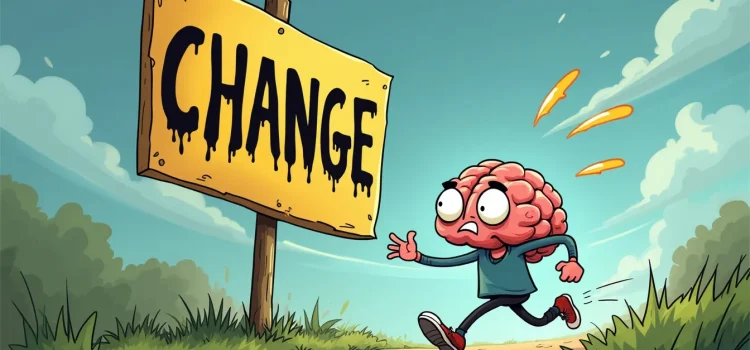

This article is an excerpt from the Shortform book guide to "One Small Step Can Change Your Life" by Robert Maurer. Shortform has the world's best summaries and analyses of books you should be reading.
Like this article? Sign up for a free trial here.
Do you want to make changes in your life but keep running into roadblocks? Do you wonder why it’s so hard to break old habits and form new ones?
In One Small Step Can Change Your Life, Dr. Robert Maurer explains the psychology of change, revealing fascinating insights into our brain’s resistance to new behaviors. Understanding how our minds perceive and react to change can help us overcome obstacles and achieve our goals more effectively.
Keep reading to learn why change is so hard.
The Psychology of Change
Clinical psychologist Robert Maurer discusses the psychology of change, explaining that change is often difficult to implement because it triggers your fight-or-flight response. To ensure survival, your ancestors had to constantly stay alert to danger so that they could react swiftly to threats in their environment. Hundreds of years later, though the environment is now less threatening, your instinct to avoid danger hasn’t evolved. However, instead of protecting you from threats to your survival, this instinct now sets off alarm bells whenever you attempt to depart from your habitual, safe routine. In other words, your brain perceives any change, from major life changes to minor habit adjustments, as a threat.
(Shortform note: Nicole LePera (How to Do the Work) adds insight into why change feels threatening by explaining two key points about your subconscious mind (the brain region that manages the fight-or-flight response): 1) Your subconscious mind creates default patterns based on what you think, feel, and do most often so that you can engage in your routines automatically, without conscious thought. 2) Your subconscious mind believes that your default patterns keep you safe and must be preserved—so it resists changing them by creating discomfort (including feelings of fear and anxiety) each time you deviate from your default patterns. It creates this discomfort to convince you to revert to your default patterns.)
Maurer explains that this involuntary response hinders change in two ways: First, in fight-or-flight mode, your brain prioritizes instinctual survival responses (fight, flight, or freeze) to guide you toward safety. This process shuts down the parts of your brain responsible for conscious thought and problem-solving, which impedes your ability to think clearly, plan effectively, and make the rational decisions necessary for implementing change. For example, when considering a career change, you might find yourself frozen by indecision rather than being able to logically weigh the pros and cons.
| The Emotional and Rational Brain Systems Bessel van der Kolk (The Body Keeps the Score) further explains that your brain comprises several separate systems, each responsible for different aspects of bodily function, emotion, and consciousness. Your brain’s emotional systems are quicker to respond to potential threats than your rational system because in a true survival situation, quick emotion-driven responses (such as fearfully jumping away from a predator) keep you alive, whereas stopping to think rationally might get you killed. However, it takes only a few milliseconds for your rational system to catch up and help you determine whether the threat is real. This implies that you can consciously respond to change once your rational system has had a chance to process the situation. |
The fight-or-flight response also induces fear. The larger the change and the more it matters to you, the stronger the fear you feel. This fear can be deeply uncomfortable, leading you to resist change and default to familiar routines that sabotage your efforts. For example, you may want to adopt a healthier lifestyle—but find yourself reaching for junk food and skipping the gym to avoid the discomfort that comes from stepping out of your comfort zone.
(Shortform note: Psychologist Prescott Lecky’s self-consistency theory sheds light on why larger changes induce more fear. He argues that your subconscious mind is programmed to protect your beliefs about yourself and to align your behaviors with these beliefs. This means that your behaviors always reflect your self-beliefs and that your subconscious mind resists adopting behaviors that contradict these beliefs. It follows that the bigger the change you attempt to make to your behaviors (and therefore to your beliefs), the more threatened your subconscious mind feels—and the more psychological discomfort (fear) it creates to resist this change.)
Small Actions Bypass Your Fight-or-Flight Response
Does your inevitable fight-or-flight response to change mean that you’re forever bound to suffer from cognitive resistance and fear when attempting change? Fortunately, this doesn’t have to be the case. Maurer suggests a way to bypass your fight-or-flight response and embrace change with confidence and ease: Take very small, incremental actions toward your goals.
Taking small, easy actions enables you to sneak past your internal alarm system, preventing your fight-or-flight response from kicking in. This allows the parts of your brain responsible for conscious thought and problem-solving to stay active and engaged and diminishes the fear that typically accompanies the process of change.
Beyond these immediate benefits, Maurer says that this incremental approach supports your ability to implement change by helping you build momentum and establish new behaviors.

———End of Preview———
Like what you just read? Read the rest of the world's best book summary and analysis of Robert Maurer's "One Small Step Can Change Your Life" at Shortform.
Here's what you'll find in our full One Small Step Can Change Your Life summary:
- Why it's often difficult to make the changes you want
- How to avoid your fight-or-flight response and move forward instead
- Simple strategies to transform seemingly daunting goals into enjoyable and attainable ones






